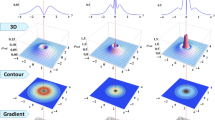Abstract
Fast and reliable prediction of bond orders in organic systems based upon experimentally measured quantities can be performed using electron density features at bond critical points (J Am Chem Soc 105:5061–5068, 1983; J Phys Org Chem 16:133–141, 2003; Acta Cryst B 61:418–428, 2005; Acta Cryst B 63:142–150, 2007). These features are outcomes of low-temperature high-resolution X-ray diffraction experiments. However, a time-consuming procedure of gaining these quantities makes the prediction limited. In the present work we have employed an empirical approach AlteQ (J Comput Aided Mol Des 22:489–505, 2008) for evaluation of electron density properties. This approach uses a simple exponential function derived from comparison of electron density, gained from high-resolution X-ray crystallography, and distance to atomic nucleus what allows calculating density distribution in time-saving manner and gives results which are very close to experimental ones. As input data AlteQ accepts atomic coordinates of isolated molecules or molecular ensembles (for instance, protein–protein complexes or complexes of small molecules with proteins, etc.). Using AlteQ characteristics we have developed regression models predicting Cioslowski–Mixon bond order (CMBO) indexes (J Am Chem Soc 113(42):4142–4145, 1991). The models are characterized by high correlation coefficients lying in the range from 0.844 to 0.988 dependently on the type of covalent bond, thereby providing a bonding quantification that is in reasonable agreement with that obtained by orbital theory. Comparative analysis of CMBOs approximated using topological properties of AlteQ and experimental electron densities has shown that the models can be used for fast determination of bond orders directly from X-ray crystallography data and confirmed that AlteQ characteristics can replace experimental ones with satisfactory extent of accuracy.




Similar content being viewed by others
References
Lendvay G (1994) J Phys Chem 98:6098–6104
Kiralj R, Kojic-Prodic B, Zinic M, Alihodzic S, Trinajstic N (1996) Acta Cryst B 52:823–837
Blowers P, Masel RI (1998) J Phys Chem A102:9957–9964
Zhan C-G, Wang Q-L, Xiong Y, Chen XJ (2000) J Mol Struct Theochem 531:33–37
Nalewajski RF (2000) J Phys Chem A 104:11940–11951
Lewis GN (1916) J Am Chem Soc 38:762–785
Lewis GN (1923) Valence and structure of atoms and molecules. Chemical Catalogue Co., New York
Frankland E (1852) Phil Trans R Soc Lond 142:417–444
Kekulé A (1857) Annalen der Chemie und Pharmacie 104:129–150
Kekulé A (1858) Annalen der Chemie und Pharmacie 106:129–159
Kekulé A (1866) Annalen der Chemie und Pharmacie 137:129–136
Couper AS (1858) Annales de Chimie et de Physique 53:469–489
Thomson JJ (1897) Phil Mag S 5(44):293–316
Bohr N (1913) Phil Mag S 6(26):1–24
Bohr N (1913) Phil Mag S 6(26):476–502
Bohr N (1913) Phil Mag S 6(26):857–875
Burrau Ø (1927) Danske Vidensk Selsk Math-fys Medd 7(14):1–18
Burrau Ø (1927) Naturwissenschaften 15:16–17
Heitler W, London F (1927) Zeitschrift für Physik 44:455–472
Lennard-Jones JE (1929) Trans Faraday Soc 25:668–686
Cioslowski J, Mixon ST (1991) J Am Chem Soc 113(42):4142–4145
Coulson CA (1939) Proc R Soc Lond A 169:413–428
Mulliken RS (1955) J Chem Phys 23:1833–1840
Mulliken RS (1955) J Chem Phys 23:1841–1846
Mulliken RS (1955) J Chem Phys 23:2338–2342
Mulliken RS (1955) J Chem Phys 23:2343–2346
Wiberg KB (1968) Tetrahedron 24:1083–1096
Mayer I (1983) Chem Phys Lett 97:270–274
Mayer I (1986) Int J Quantum Chem 29:477–483
Kaufman JJ (1970) Int J Quantum Chem 5:205–208
Ham NS (1958) J Chem Phys 29:1229–1231
Angyan JG, Loos M, Mayer I (1994) J Phys Chem 98:5244–5248
Angyan JG, Rosta E, Surjan PR (1999) Chem Phys Lett 299:1–8
Bridgeman AJ, Cavigliasso G, Ireland LR, Rothery JJ (2001) J Chem Soc Dalton Trans 14:2095–2108
Mayer I, Knapp-Mohammady M, Suhai S (2004) Chem Phys Lett 389:34–38
Lennard-Jones JE (1937) Proc R Soc Lond A 158:280–296
Bader RFW (1990) Atoms in molecules: a quantum theory. Oxford University Press, Oxford
Bader RFW, Slee TS, Cremer D, Kraka E (1983) J Am Chem Soc 105:5061–5068
Howard ST, Lamarche O (2003) J Phys Org Chem 16:133–141
Stash AI, Tanaka K, Shiozawa K, Makino H, Tsirelson VG (2005) Acta Cryst B 61:418–428
TsirelsonVG, Bartashevich EV, Stash AI, Potemkin VA (2007) Acta Cryst B 63:142–150
Potemkin VA, Grishina MA (2008) J Comput Aided Mol Des 22:489–505
Schmidt MW, Baldridge KK, Boatz JA, Elbert ST, Gordon MS, Jensen JH, Koseki S, Matsunaga N, Nguyen KA, Su S, Windus TL, Dupuis M, Montgomery JA Jr (1993) J Comp Chem 14:1347–1363
AIMPAC suite of software applications http://www.chemistry.mcmaster.ca/aimpac/imagemap/imagemap.htm. Accessed April 8, 2013
Potemkin VA, Rykounov AA, Bartashevich EV, Pereyaslavskaya ES, Stash AI, Tsirelson VG (2006) IV National Crystal Chemistry Conference, 26–30 June 2006, Russia, Chernogolovka: Book of Abstracts, p 75
Tsirelson VG, Stash AI, Potemkin VA, Rykounov AA, Shutalev AD, Zhurova EA, Zhurov VV, Pinkerton AA, Gurskaya GV, Zavodnik VE (2006) Acta Cryst B 62:676–688
Potemkin VA, Rykounov AA, Stash AI, Tsirelson VG (2006) IV National Crystal Chemistry Conference, 26–30 June 2006, Russia, Chernogolovka: Book of Abstracts, p 130
Hansen NK, Coppens P (1978) Acta Cryst A 34:909–921
Zhurova EA, Matta CF, Wu N, Zhurov VV, Pinkerton AA (2006) J Am Chem Soc 128:8849–8862
Hibbs DE, Overgaard J, Howard ST, Nguyen TH (2005) Org Biomol Chem 3:441–447
Acknowledgments
We are grateful to Prof. Vladimir G. Tsirelson and Dr. Adam I. Stash for the low-temperature high-accurate X-ray diffraction experiment data.
Author information
Authors and Affiliations
Corresponding author
Rights and permissions
About this article
Cite this article
Salmina, E., Grishina, M.A. & Potemkin, V.A. An approximation of the Cioslowski–Mixon bond order indexes using the AlteQ approach. J Comput Aided Mol Des 27, 793–805 (2013). https://doi.org/10.1007/s10822-013-9677-z
Received:
Accepted:
Published:
Issue Date:
DOI: https://doi.org/10.1007/s10822-013-9677-z




